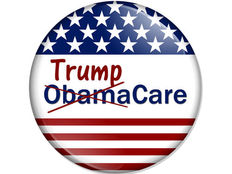
The entire capital market, along with investors, is eagerly waiting, and somewhat predicting, the short- and long-term impacts of President Trump’s healthcare policies and the GOP’s replacement plans. Municipal markets are no exception.
Small and large healthcare facilities, already reeling under much scrutiny, will closely watch the senate vote on the proposed healthcare replacement bill early next week. These entities are interested in evaluating the potential financial burden the proposed bill might create for their core operations.
In this article, we’ll take a closer look at the proposed Republican healthcare bill, how it compares to the Affordable Care Act (ACA) aka Obamacare, and how the financial burden of uninsured patients may be shifted back to the hospitals. Furthermore, we’ll examine the impact of this reform on hospital finances and the potential impact on debt repayment capacities.
Key Implications About the Trumpcare Versus Obamacare Debacle
Early next week, the Senate will have a second chance to repeal and replace critical elements of Obamacare. Rifts within Republicans have led to delays in reaching a potential decision, and the first attempt to go over the replacement bill was stalled during the first week of June. A replacement of the components of Obamacare has the potential to reshape the American healthcare ecosystem. As a result, it’s crucial to examine the key tenets of this bill and how it compares with Obamacare.
Prevalence of uninsured Americans: The issue of people losing their health insurance coverage under the replacement plan has been the centerpiece of discussions amongst Democrats and even some Republicans. Under the new plan, there is a series of huge cuts to the federal aid for low-income individuals that rely on Medicaid or qualify for federal subsidies under ACA. If the federal subsidies are reduced or cut, approximately 23 million people will no longer be able to afford healthcare under the new plan.
The proposed changes in Medicaid are also significant; currently, federal and state government shares the cost of insuring Americans under the poverty line. With the replacement, the federal “sharing of cost” will be limited to a block grant, which means that each state will receive a limited amount of money to meet its Medicaid needs. Furthermore, any expansions to Medicaid, under Obamacare, would be eliminated by the year 2020. As a result, state finances might come under pressure, and hospitals need to be come up with ways to become more and more self-reliant.
Insurance cost ramifications: President Trump and his administration have often spoken about lowering the cost of healthcare in the U.S. Under the replacement plan, insurance premiums are likely to be cheaper after 2020 than Obamacare. However, these insurance plans will have higher out-of-pocket expenses and cover less than what is currently on offer under Obamacare. In short, it is quite likely that less resourceful American patients would feel the heat.
Radical changes in insurance mandates: Under Obamacare, every individual was required to purchase health insurance or pay a tax penalty. Under the GOP’s proposal, the insurance mandate will be eliminated but potentially replaced with a big premium surcharge for someone who goes without health insurance for over two months.
In addition, provisions like Guaranteed Coverage is likely to stay in place; however, women’s health provisions will be handed back to the individual states, which can then seek waivers to allow insurers to eliminate benefits like contraceptives. At the same time, Medicaid would be barred from providing funding for any health clinics that provide abortion services, including Planned Parenthood.
Check out the risks associated with Obamacare for muni bondholders here.
Beware of Smaller and Less-Diversified Hospitals
As mentioned earlier, under Obamacare, nearly 23 million Americans became new members of the healthcare insurance system, and these new insurers create revenue streams for hospitals. If these newly insured Americans are thrown off their insurance plans and left uninsured, this will dry up those revenue streams. Furthermore, this can be even more worrisome for smaller hospitals that operate on tighter budgets, making a worse situation even worse. This was evident after Trump’s victory when the healthcare debt index rose drastically because investors demanded higher yields to compensate for the regulatory uncertainties. In addition, credit rating agencies are also watching this sector very closely to ensure that revenue streams are strong and bond covenants are not breached.
Let’s take a quick look at two recent issuances and how the repeal of Obamacare might impact them. In conjunction with hospital and developing authorities, Fulton County issued CUSIP 3599008G5, worth $198 million. This revenue bond with strong bond indentures can be severely impacted by the lower number of insurers due to no mandates for individual health coverage. Among the bigger issuers, Henderson Nevada Heath Care Facility issued CUSIP 42503CF1, worth $192 million. This revenue-pledged muni for a project jointly developed by two major cities (total issuance is over $450 million) is in a much better position to bear major changes to Obamacare. The revenue streams, geographic location and infrastructure dependency on more than one or two programs or insurers are much more diversified and safer for muni investors compared to the Fulton County debt issuer.
A diversified portfolio always serves an investor well, even if it’s heavily concentrated in healthcare debt. It would pay off in the long run if you, as an investor, carefully examine the characteristics of the patient base of the healthcare debt issuer. For this, it is also important to keep an eye on the opinions provided by the credit rating agencies, and adjust portfolios accordingly. Finally, it would also be wise to analyze the impact of regulatory decisions on cash flow projections. For instance, if you see Obamacare-dependent revenues streams for a particular hospital, you might also want to consider some other hospitals that have more diversified revenue sources.
Check out the different ways to invest in muni bonds to stay up to date with the current investment strategies.
Keep our glossary of municipal bond terminologies handy to familiarize with different concepts commonly used by municipal investors.
The Bottom Line
The upcoming potential repeal and replacement of Obamacare will bring plenty of unrest to the healthcare industry, as every healthcare provider, healthcare facility and insured patients will need to examine the overall impact and brace themselves for huge financial strains.
Some hospitals and healthcare providers have built or made drastic changes to their infrastructure based on Obamacare, which may not be very sustainable going forward. It may not be a bad idea, for the time being, to either stay away from healthcare investments or to thoroughly examine the sustainability of the revenue streams backing their debt.
Be sure to visit our Market Activity Section here to explore recent muni bond trades.
By becoming a premium member, you can get immediate access to all the latest Moody’s credit reports for municipal bonds across the U.S. and enhance your analysis for a specific security.






